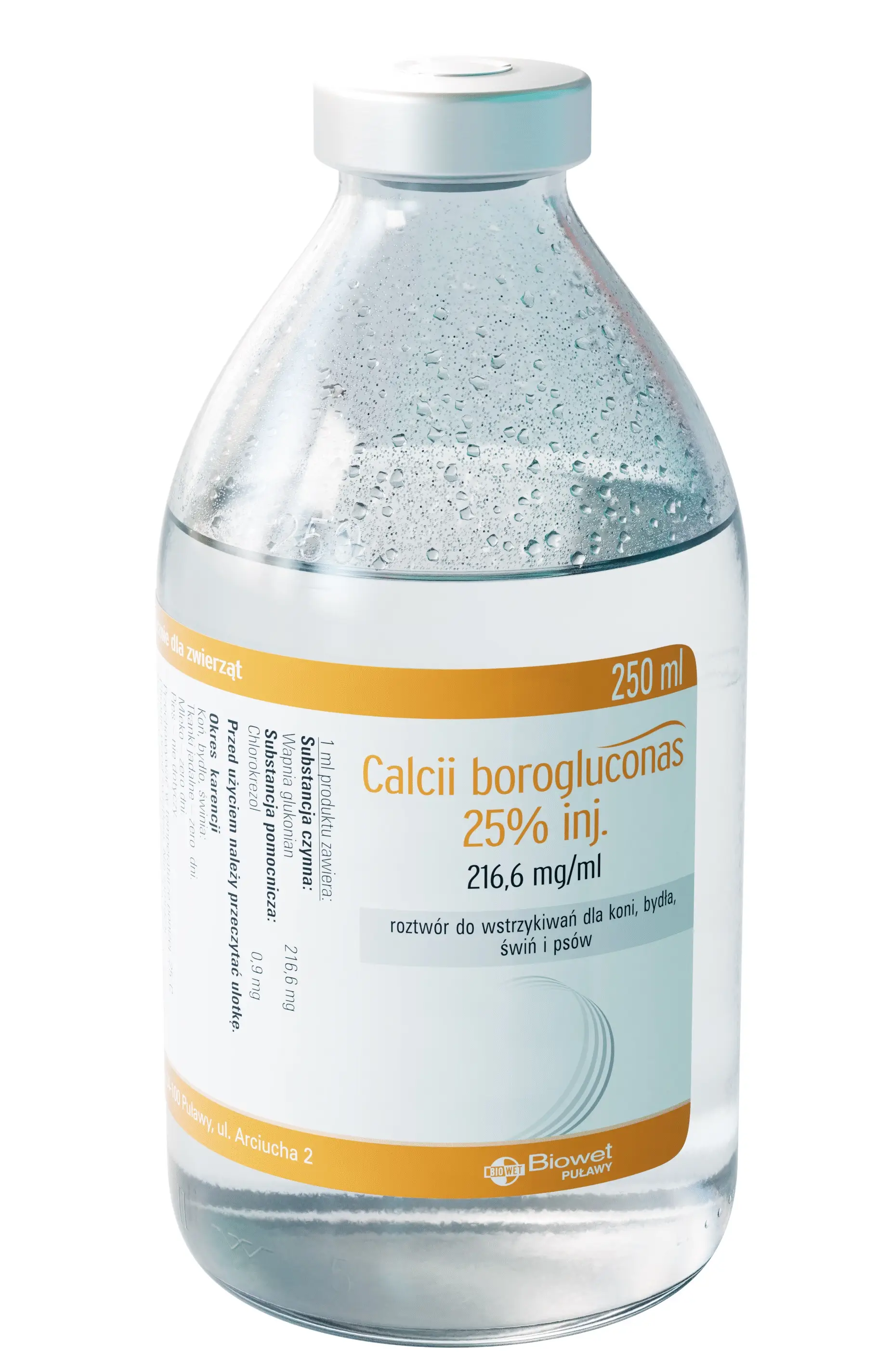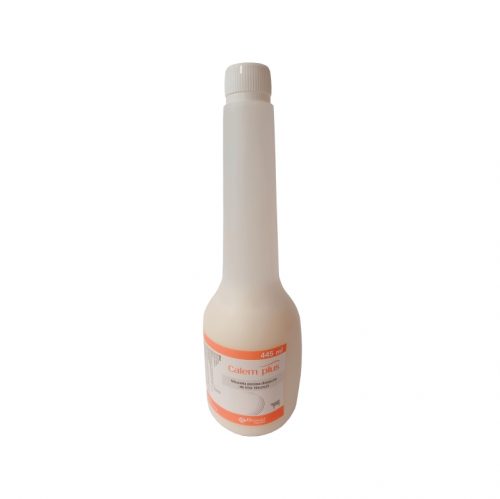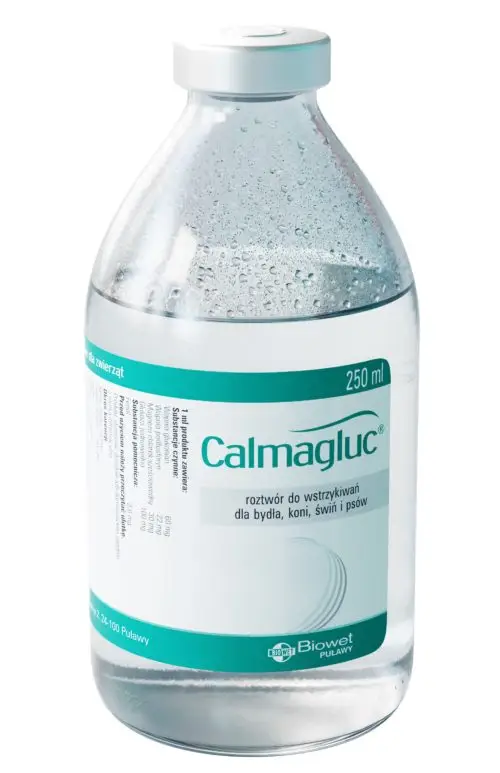Beschreibung
Solution for injections for horses, cattle, swine and dogs.
QUALITATIVE AND QUANTITATIVE COMPOSITION OF THE ACTIVE SUBSTANCE
Calcium gluconate 216.6 mg/ml
INDICATIONS
Calcium deficiencies and their consequences in cattle, horses, swine and dogs (rickets, osteomalacia, osteodystrophy).
Treatment of calcium metabolism disorders leading to hypocalcaemia (post-partum paralysis in cows, lactation tetany in bitches, post-partum hypocalcaemia in sows) and conditions accompanied by excessive neuromuscular excitability (hypomagnesemic tetany, transport tetany and other) or by paresis of the motor system of various origins (downer syndrome).
Inflammations and allergic conditions, especially the acute ones and ones with urticaria, as well as swellings and reduced blood coagulability (as supporting drug).
CONTRAINDICATIONS
Renal insufficiency, hepatic insufficiency, hyperparathyroidism and hypercalcaemia.
Do not administer with digitalis glycosides and large doses of vitamin D3.
ADVERSE REACTIONS
When used in accordance with recommendations, the preparation is well tolerated and no complications are observed after multiple applications either. Sporadically, in the case of large doses in animals in generally poor condition, hypercalcaemia may occur during intravenous infusions: initially brachycardia appears, then the contraction intensifies and its frequency increases, resulting in tachycardia and additional contractions. Acute hypoxia of the cardiac muscle appears, followed by muscle twitching, anxiety, sweating, reduced arterial blood pressure leading to a collapse. In order to correctly recognise the symptoms of the overdose, cardiac activity should be monitored during the infusion.
If the drug is improperly administered and if it leaks out, local inflammatory reactions may appear.
In the case of intramuscular injections, in dogs also subcutaneous, animals may exhibit slight or moderate anxiety.
Should any adverse effects or any reactions not mentioned in the leaflet occur (including reactions in humans due to the contact with the preparation), please contact your veterinarian or inform the marketing authorisation holder or the Office for Registration of Medicinal Products, Medical Devices and Biocides. The application form ought to be downloaded from the website: https://www.urpl.gov.pl (Department of Medicinal Veterinary Products).
DOSAGE AND ROUTES OF ADMINISTRATION
The preparation is used intravenously and intramuscularly. In dogs it can also be given subcutaneously.
Using intravenously, the preparation should be warmed up to body temperature and injected slowly.
25-50 ml/min.
In intramuscular and subcutaneous injections, administer the preparation in several locations: 20-40 ml in each location in large animals and 2-3 ml in each location in small animals.
The dose amount should depend on the nature of the disease and on the general condition:
0.8 ml/kg b.w in the case of acute hypocalcaemia
0.4 ml/kg b.w in the case of morphological skeletal diseases, acute or aseptic inflammations
0.2 ml/kg b.w. in the case of inflammations, poisoning, or haemorrhagic diathesis.
ADVICE ON CORRECT ADMINISTRATION
None
WAITING PERIOD
Horses, cattle, swine – 0 days.
Dogs – not applicable.
SPECIAL STORAGE AND TRANSPORT PRECAUTIONS
Store at a temperature below 25°C, protect from light, and do not freeze.
Use within 28 days after the first opening of the direct container.
Do not use after the expiry date which is stated on the label.
SPECIAL WARNINGS AND PRECAUTIONS
For animal treatment only.
Keep out of the reach and sight of children.
Prescription drug.
No contraindications for pregnancy or lactation.
Do not administer with cardiac glycosides or preparations containing carbonate, phosphate, sulphate ions or tetracycline antibiotics.
Large calcium doses administered simultaneously with cardiac glycosides (of strophanthin- and digoxin-derivatives) intensify their effects and may lead to cardiac arrhythmia.
Thiazide diuretics increase calcium resorption and create a risk of hypercalcaemia.
Large doses of calcium in combination with vitamin D may weaken the effects of other calcium channel blockers.
When used in accordance with recommendations, the preparation is well tolerated and no complications were observed also after multiple applications. Sporadically, in the case of large doses in animals in generally poor condition, hypercalcaemia may occur during intravenous infusions:
Initially brachycardia appears, then the contraction intensifies and its frequency increases, resulting in tachycardia and additional contractions. Acute hypoxia of the cardiac muscle appears, followed by muscle twitching, anxiety, perspiring, reduced arterial blood pressure leading to a collapse. In order to correctly recognise the symptoms of overdose, cardiac activity should be monitored during the infusion.
Overdose leads to hypercalcaemia and the increased excretion of calcium in the urine. The symptoms of hypercalcaemia may include: nausea, vomiting, thirst, increased thirst, dehydration and constipation. Long-term overdose leading to hypercalcaemia may cause calcination of the blood vessels and internal organs. Calcium supplementation in amounts larger than 2000 mg/day, which is the threshold value, for several months may cause poisoning.
In the case of overdose, the treatment must be discontinued immediately and fluids should be supplemented. In the case of long term overdose, oral and intravenous hydration with NaCl should be applied. At the same time (or after the hydration), loop diuretics (e.g. furosemide) should be administered in order to increase calcium excretion.
In order to avoid administering too large doses, the animal’s body weight should be determined as accurately as possible.
In the case of an accidental self-injection, seek medical help and give the leaflet or the packaging to the doctor.
SPECIFIC PRECAUTIONS FOR THE NEUTRALISATION OF UNUSED VETERINARY MEDICINAL PRODUCT OR WASTE DERIVED FROM IT
Drugs should not be disposed of via wastewater or household waste. Ask a veterinary doctor about the methods of disposal of useless drugs. These measures should help to protect the environment.
OTHER INFORMATION
For any information on this veterinary medicinal product, please contact the local representative of the marketing authorisation holder.
STABILITY
24 months.
PACKAGE
Bottles of 250 ml.
13.11.2015 r.





